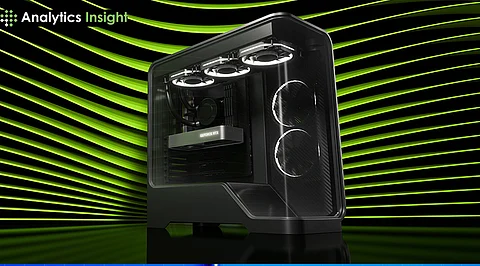

Released on March 5, 2025, the Nvidia GeForce RTX 5070 enters the market as a member of the Blackwell architecture line with mid-range capabilities priced at US$549. The card made a splash at CES 2025 by announcing RTX 4090-class performance for a small fraction of the cost. Out now, its full potential can be tried and has both advantages and disadvantages to its showing.
This review explores the RTX 5070's design, performance, features, and value under distinct sub-headings, offering a comprehensive analysis of its place in the 2025 GPU market.
The RTX 5070 Founders Edition uses a slim, two-slot design, something of a departure from the heavier RTX 5090 and RTX 5080 designs. Smaller than its more expensive relatives, it fits neatly into small PC builds, a welcome for enthusiasts of the small form factor. A dual-fan setup with a 3D vapor chamber maintains temperatures, but fan noise increases when things get hot.
The card draws 250W of power, an increase from the RTX 4070 Super's 220W, which means it needs a 650W PSU and two 8-pin PCIe cables through the use of a 12V-6x6 adapter. Though effective packaging indicates sustainability consideration, the power consumption increase defies the gains in efficiency seen in previous generations, suggesting trade-offs in Blackwell design.
With 6,144 CUDA cores distributed across 48 Streaming Multiprocessors, the RTX 5070 slightly outpaces the RTX 4070 Super's 56 SMs. 1440p benchmarks reveal it averaging 5-7% faster in Cyberpunk 2077 and Metro Exodus Enhanced, providing about 53 FPS at 4K with ray tracing active. The 12GB GDDR7 VRAM running at 672 GB/s over a 192-bit bus also surpasses the RTX 4070's GDDR6X, contributing to memory-constrained tasks.
Yet, comparisons against the RTX 4090 are overhyped—unadorned rasterization performance falls much behind, reaching more in line with RTX 3090 levels. Advances over the RTX 4070 Super are incremental, disappointing those who had hoped for a generational jump, particularly with AMD's RX 9070 on the horizon as a 16GB equivalent at the same price point.
Nvidia's DLSS 4, which is only available on the RTX 50-series, brings Multi-Frame Generation (MFG) to the table, utilizing fifth-generation Tensor Cores to increase frame rates. In games optimized for it, such as Marvel Rivals, the RTX 5070 beats the RTX 4090 at 4K, producing three AI-rendered frames for every traditional one. This gives more than 100 FPS at 1440p in Cyberpunk 2077 without MFG and even more with it turned on.
However, the technology's effect is not uniform; games such as Indiana Jones and the Great Circle reveal VRAM constraints, crashing at 4K with full ray tracing. Latency problems also show up at lower levels, and tuning is needed to ensure smoothness, robbing the RTX 5080 and 5090 of some of their "set-and-forget" appeal. Powerful as it is, DLSS 4 alone cannot fill the gap to flagship class.
At US$549, the RTX 5070 beats the RTX 4070 Super's US$599 launch MSRP, providing a slight upgrade for less. MSRP availability from the Founders Edition brings some consolation in the face of scalping issues that are rocking the RTX 5090 and 5080 releases. The 12GB VRAM buffer, however, raises eyebrows in 2025 when 16GB becomes the norm to be future-proof at this price. AMD's RX 9070, which is about to release with better memory and comparable ray tracing, overshadows Nvidia's release. The RTX 5070 is ideal for 1440p users upgrading from legacy cards such as the RTX 3070, with 40-70% gains, but lacks oomph for RTX 4070 Super users to dominate its category.
The Nvidia GeForce RTX 5070 provides decent 1440p performance, compact dimensions, and the magic of DLSS 4 upscaling, making it a respectable mid-range solution in 2025. Mild upgrades compared to the RTX 4070 Super and a lower price point appeal to budget-conscious upgraders.
However, high-sounding claims of RTX 4090 parity ring hollow without over-the-top dependence on AI wizardry, and the limitation of 12GB VRAM holds back longevity. Against impending AMD competition and its power-hungry profile, it fails to sparkle as a necessity. For the value-conscious in preference to hype, it deserves consideration, but the mid-range throne remains unsettled.
